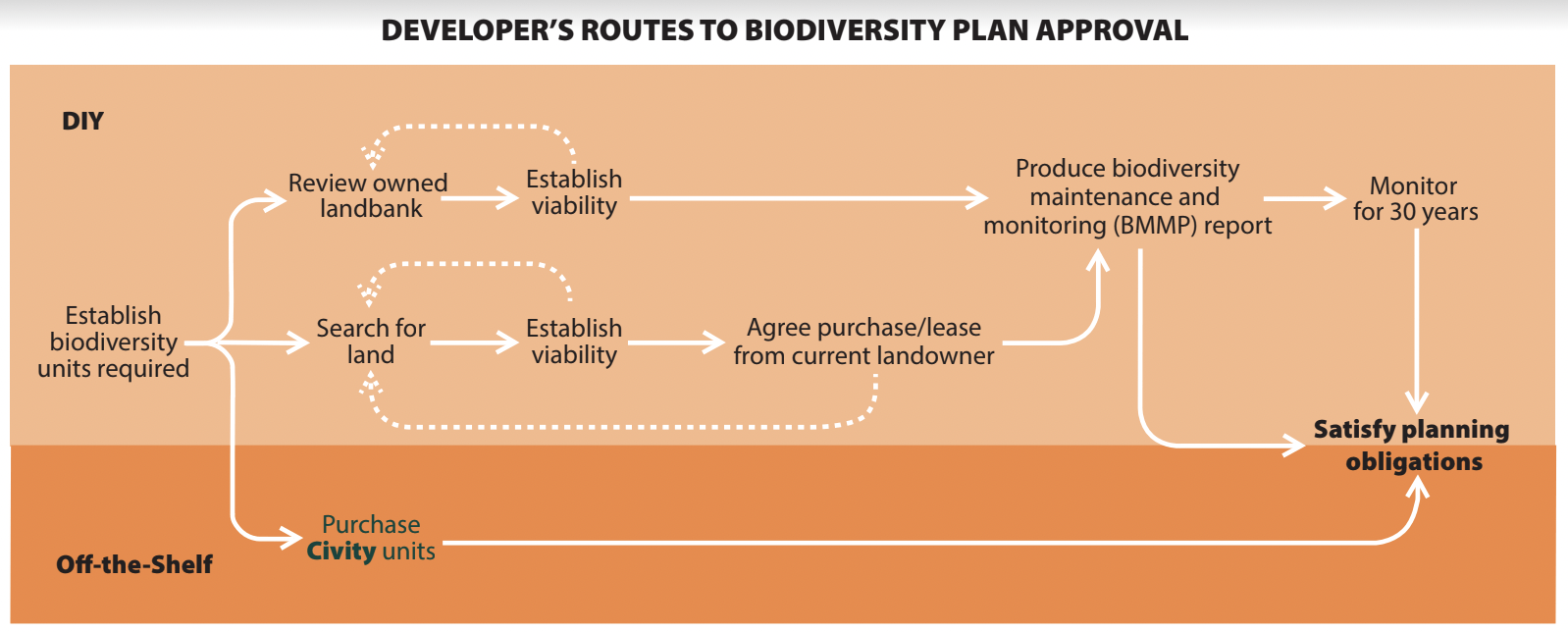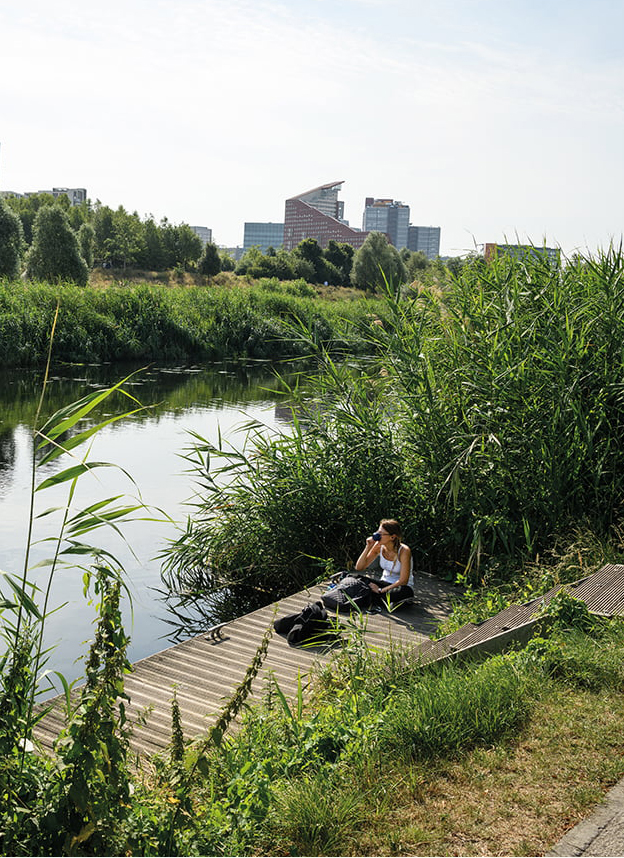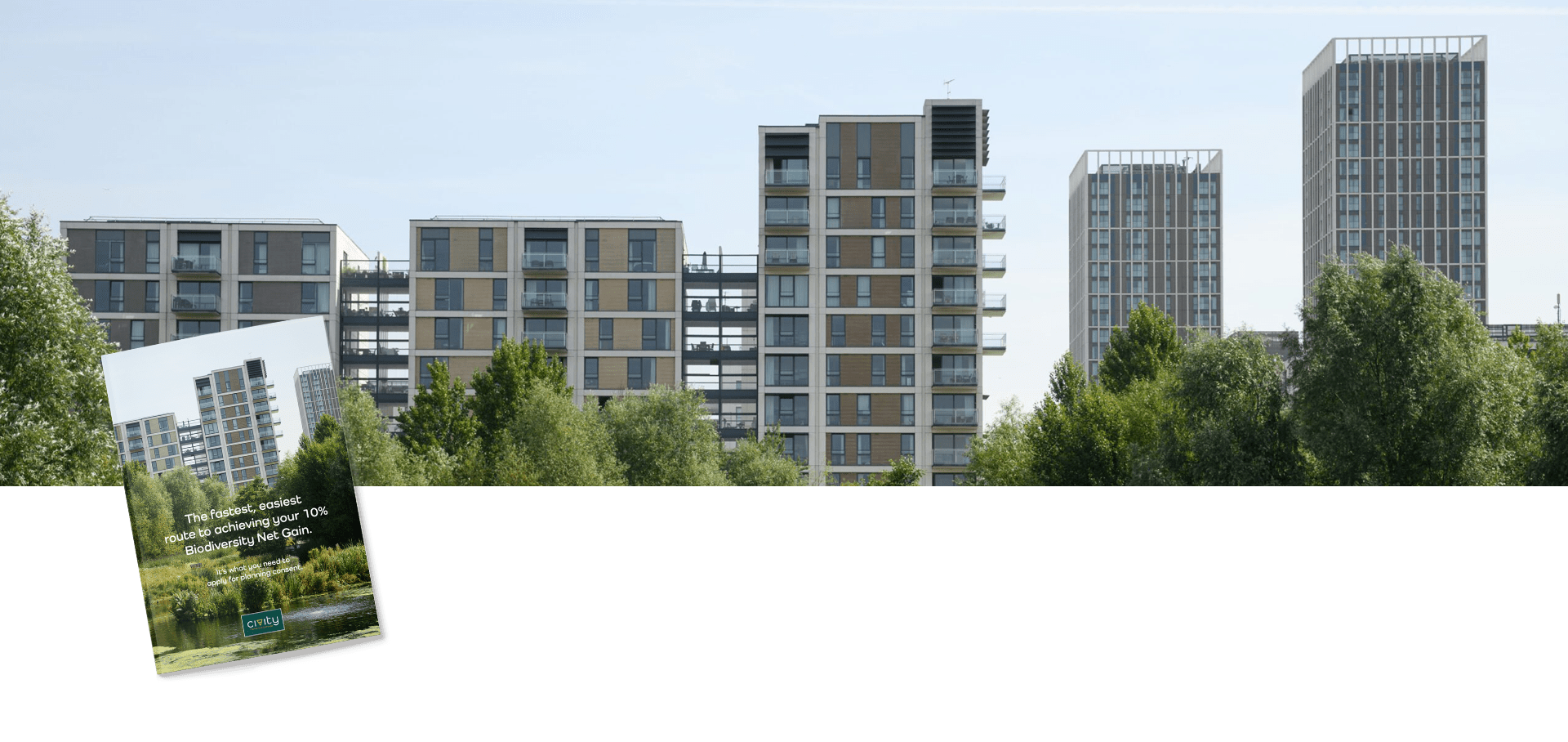Biodiversity Net Gain For Developers
Civity helps developers achieve a Biodiversity Net Gain with off-the-peg BNG Units, habitat management and consultancy.
Biodiversity Net Gain became law in February
2024. Local Planning Authorities cannot give consent to planning applications
without proof that the developer can show biodiversity net gain of 10% over the value
before development started. There are exceptions: national infrastructure projects
until 2025 and some very minor residential plans.
So, you need to know from a qualified, experienced ecologist what your 10% BNG requirement is, where you can buy the biodiversity units and what type of habitat you need. The quickest and most direct route is to contact Civity.

Three routes to biodiversity units
There are three routes for acquiring the biodiversity units your development plan needs before applying for planning permission (see below).
The “DIY” Routes:

By managing/monitoring other land you already own yourself within your own landbank. This could be onsite, offsite or both.

By leasing or purchasing land and managing/monitoring it yourself.
The “Off-the-shelf” route

By going direct to a landbank, such as Civity, which, as you can see below, is faster and removes all further responsibility and risks for 30 years.

How it works
If you, the developer, choose either of the DIY routes, you may meet some snags along the way. These are represented as dotted lines that take you back a stage. Assuming you have found the land to convert into biodiversity units, there are four factors which may crop up as you progress:
- Does that land produce enough biodiversity units to meet the 10% gain?
- Is the quality and type of habitats impacted by your development being replaced like-for-like or better? If not, you will need search for land that meets the criteria.
- How far from your development site are the replacement habitats? A “Spatial Risk Multiplier” may be applied that decreases the value of biodiversity units relative to the distance the between your site and the land you have found.
- If it’s not land that you currently own, can you agree a purchase/lease price or management agreement with the current owner?
Any, or all, of these factors could require a revaluation of the biodiversity units required OR the need to search for more, or other, land. In other words, you may have to start again.
Civity’s off-the-shelf offer cuts the time, cost and effort. The journey is short; the transaction can be quick and you have no residual long term obligations because Civity takes them on.


The Advantages

Off-the-shelf. Civity can provide biodiversity units for upcoming planning applications as well as consultation to ensure a smooth transit through the planning process.

Fast. The acquisition of biodiversity units is much faster than purchasing suitable land.

Maintenance-free. Civity takes over the responsibility for maintaining and monitoring the land for 31 years.

Asset-efficient. No need to tie up funds in the land that serves little purpose to the developer.

No risk. Civity will absorb all the legal liability and planning implications for delivering the units you purchase.

Expertise. Civity has its roots in ecology, biodiversity and planning.

How Civity can help developers with Biodiversity Net Gain
Civity balances the need of expanding development with our disappearing wildlife habitats. We understand the pressures on both sides of the fence. Civity is:

An ethical business helping developers

A growing landbank that creates biodiversity units for developers.

A specialist company with a board of directors experienced in ecology, land and the residential, commercial and industrial property markets.

A consultancy that marries the science of ecology with the economics of society.

An ecological company that works closely with local nature recovery strategies
We also commit to reinvesting part of our company profits back into community-based projects.



Preparing your biodiversity net gain plan
Your local nature recovery strategy authority will require a detailed BNG plan. To complete and comply, the following factors should be taken into account:

Planning applications (with few exceptions such as small householder applications) will not be considered without a biodiversity net gain Units plan.

A biodiversity net gain plan is a document stating how habitats will be managed for 30 years and who is responsible for their creation/maintenance.

A biodiversity net gain plan can be used to specify how you (the developer) will deliver biodiversity net gain your own biodiversity units, or can name a broker (such as Civity) from whom “off-the-shelf” offsite biodiversity units will be purchased.

Only approved providers like Civity can issue “off-the-shelf” biodiversity units.

Local planning authorities will prioritise achieving net gain onsite but often, offsite units will be required as an offset to achieve the mandatory 10% gain measured by the biodiversity metric.

If a developer cannot achieve a gain of 10% onsite, local authorities would prefer an alternative site within their boundaries over a site beyond them.

Developers have up to 12 months to start the offset work but it is often beneficial to start the creation/enhancement of the habitat early.

For the time being, Biodiversity Net Gain applies only to England.


Free 8-page brochure for developers
Written for property developers, this illustrated booklet shows how to get your BNG plan approved. It is an essential step in the process of obtaining planning permission (unless, of course, you already have it).
It covers how the BNG rules relate to the various types of habitats that might be demolished or damaged by your development and how to compensate for them.
There is also a useful Glossary of commonly-used terms to help you understand the benefits and challenges that come with the BNG legislation as well as DEFRA’s definitions of habitat
types upon which BNG transactions depend.

Our Top Biodiversity Net Gain FAQs For Developers
The purpose of a Biodiversity net gain plan is to enable local planning authorities to assess how the adverse impacts on habitats have been minimised and what steps have, or will, been taken to maintain the natural environment over 31 years. Approval of the BNG plan must be submitted in advance of the planning permission application. It will include:
- the type of habitat concerned
- the pre-development and post-development value of the onsite habitat calculated by an ecologist using the DEFRA metric calculator
- the offsite value of the habitat(s)
- its distance from the development site
- any biodiversity units purchased.
Yes! The Environment Act Is clear that the offset should be on the development site and, if not, as close as possible. The effect of the development projects on the biodiversity of the land must be included in delivering the Biodiversity Net Gain Plan. A “Spatial Risk Multiplier” diminishes the biodiversity value of the offsite land in proportion to its distance from the development site if the offset is far removed from the development site.
It all depends on what is required. We work with licensed and experienced ecologists offering consultancy services and/or practical support as follows:
- Habitat creation surveys and biodiversity metric valuations.
- Biodiversity metric calculations to establish the Biodiversity Net Gain approach required for any given site.
- Bespoke searches for land and identification of offsetting opportunities for developers.
- Implementing the creation, protection, biodiversity improvements and management of habitat creation in biodiversity offset sites.
- Liaising with planning authorities, estate owners and other stakeholders.
Civity works closely with Local Planning Authorities; it has a wealth of knowledge of the environmental law, the planning process as well as scientific and on-the-ground experience of local ecology. All this is available to biodiversity net gain for developers through Civity’s consultancy services. We will work alongside your team to create a logical, comprehensive plan expressed in terms the planners like to see and you will understand.
It is incumbent on developers to find the biodiversity units or statutory biodiversity credits needed to offset their biodiversity loss.
The biodiversity value of a piece of land is assessed in biodiversity metrics. Factors influencing the valuation include:
- The location relative to the site of biodiversity damage (e.g., the development site).
- The location in relation to neighbouring land.
- The site’s size. If necessary, its value can be part of an aggregated series of plots.
- Any existing use of the land as a habitat and the condition it is in.
- Its use by rare protected species.
- Its proneness to exceptional weather conditions.
- Protection from future changes in land use (section 106 or conservation covenants).
conservation covenants).
If there is a shortfall in the development’s biodiversity score, biodiversity units may be bought from various sources. To find them, the developer can:
- consult a professional advisor
- ask the local planning authority
- Go direct to a landowner
- Ask Civity by clicking here
Biodiversity credits are units sold by the government at a deliberately high price to encourage the market to find its own levels for biodiversity units. Biodiversity units can be bought from authorised sellers such as landowners, land banks and land agents.

For More FAQs

More About Biodiversity Net Gain
Contact Us
Please feel free to contact us if you are a developer interested in Biodiversity Net Gain. We are available to start a conversation to help you navigate your biodiversity net gain needs.

